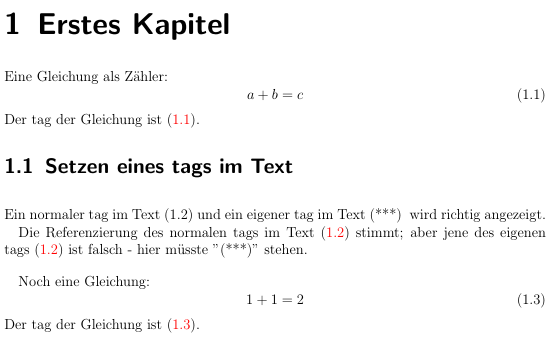|
Nochmal Frage neu aufgezogenIch möchte die gewöhnte Gleichungsnummerierung und label manuell und an beliebiger Stelle verwenden. Z.B. in einem array. Mit dem Kommando Aber bei einem tag mit eigener Gestalt funktioniert noch Öffne in Overleaf
\documentclass[12pt]{scrreprt} \usepackage{amsmath, amsfonts, amssymb} \newcommand{\tagx}[1][]{\refstepcounter{equation}(\theequation)\label{#1}} \newcommand\mytag[2][]{\begingroup \renewcommand{\theequation}{#2}% ändern (\theequation)\label{#1} % ausschreiben \endgroup } % \renewcommand{\theequation}{\refstepcounter{equation}(\theequation)} \usepackage[colorlinks=true]{hyperref} \begin{document} \chapter{Erstes Kapitel} Eine Gleichung als Zähler: \begin{equation} a+b=c\label{eq:foo1} \end{equation} Der tag der Gleichung ist \eqref{eq:foo1}. \section{Setzen eines tags im Text} \bigskip Ein normaler tag im Text \tagx[eq:bar0] und ein eigener tag im Text \mytag[eq:bar1]{***} wird richtig angezeigt. Die Referenzierung des normalen tags im Text \eqref{eq:bar0} stimmt; aber jene des eigenen tags \eqref{eq:bar1} ist falsch - hier müsste "(***)" stehen. \bigskip Noch eine Gleichung: \begin{equation} 1+1=2\label{eq:foo2} \end{equation} Der tag der Gleichung ist \eqref{eq:foo2}. \end{document} |
Folgen dieser Frage
Per E-Mail:Wenn sie sich anmelden, kommen Sie für alle Updates hier in Frage
Per RSS:Markdown-Grundlagen
- *kursiv* oder _kursiv_
- **Fett** oder __Fett__
- Link:[Text](http://url.com/ "Titel")
- Bild?
- nummerierte Liste: 1. Foo 2. Bar
- zum Hinzufügen ein Zeilenumbruchs fügen Sie einfach zwei Leerzeichen an die Stelle an der die neue Linie sein soll.
- grundlegende HTML-Tags werden ebenfalls unterstützt
Frage-Themen:
gestellte Frage: 18 Mai '19, 18:48
Frage wurde gesehen: 3,402 Mal
zuletzt geändert: 19 Mai '19, 19:18


Wenn du einen Zähler referenzieren willst, musst du
\refstepcounterstatt\stepcounterverwenden.Frage neu aufgezogen!
Lösung von @David Carlisle https://tex.stackexchange.com/questions/491625/amsmath-how-can-i-use-the-equation-numbering-and-label-manually-and-anywhere/491630#491630